Financial Reporting 1: Analysis of Patents and Depreciation - ACCM4200
VerifiedAdded on 2023/03/23
|9
|2451
|36
Report
AI Summary
This document presents a comprehensive solution to a Financial Reporting 1 assignment, addressing key accounting principles and standards. The assignment focuses on two primary issues: accounting for patents and depreciation charges on Property, Plant, and Equipment (PPE). The solution meticulously analyzes the accounting treatment of patents, including both acquired patents and internally generated intangible assets, referencing AASB 138. It examines recognition, initial measurement, and subsequent measurement, including the choice between cost and revaluation models. The second part of the solution delves into depreciation of PPE, specifically equipment, adhering to AASB 116. It covers the recognition, measurement, and depreciation methods, emphasizing the importance of useful life, residual value, and the systematic allocation of depreciation charges. The analysis incorporates relevant case studies and references to support the accounting treatments. The document also addresses the different depreciation methods like straight-line, diminishing balance and production units, and provides a detailed analysis of each, ensuring compliance with the accounting standards.
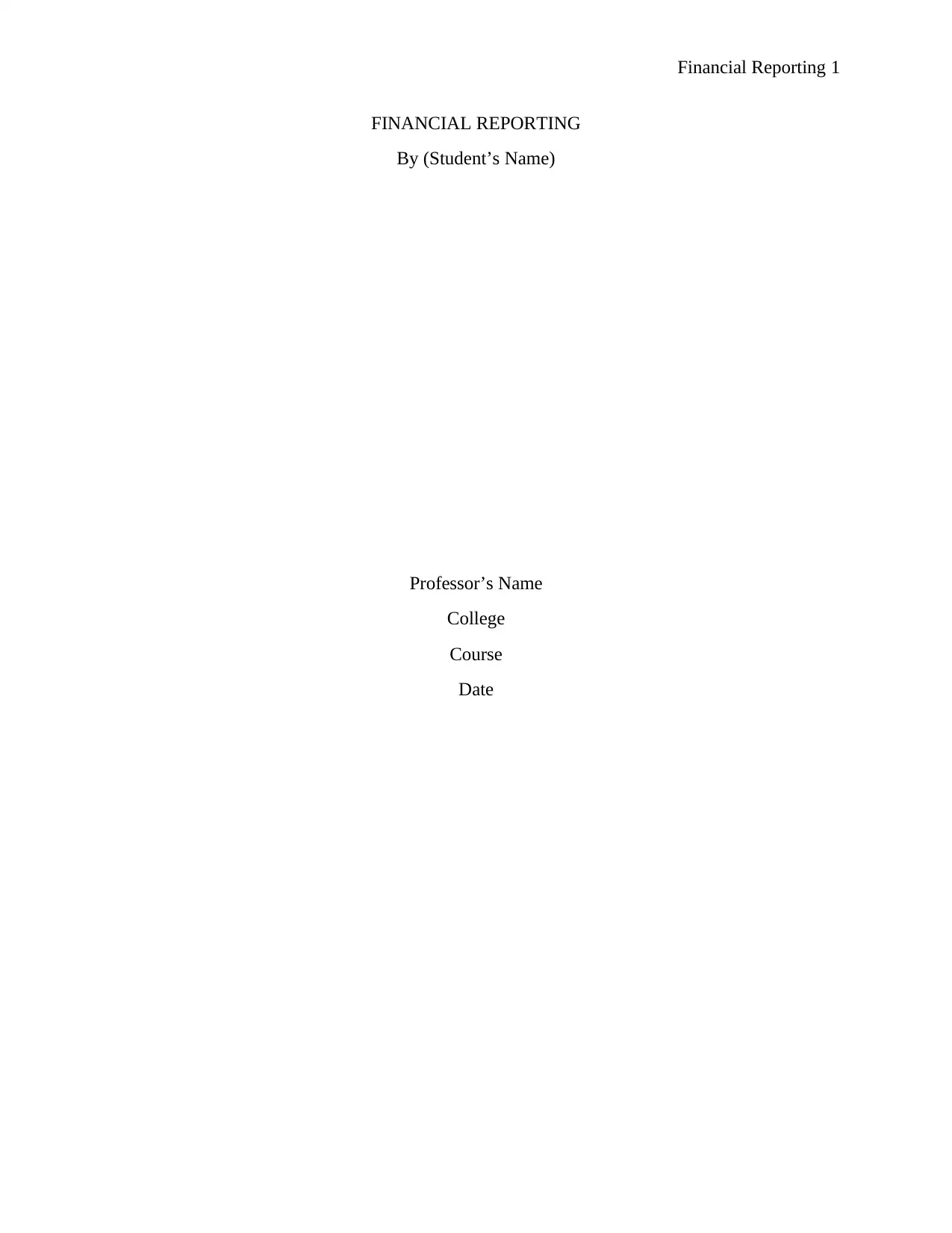
Financial Reporting 1
FINANCIAL REPORTING
By (Student’s Name)
Professor’s Name
College
Course
Date
FINANCIAL REPORTING
By (Student’s Name)
Professor’s Name
College
Course
Date
Paraphrase This Document
Need a fresh take? Get an instant paraphrase of this document with our AI Paraphraser
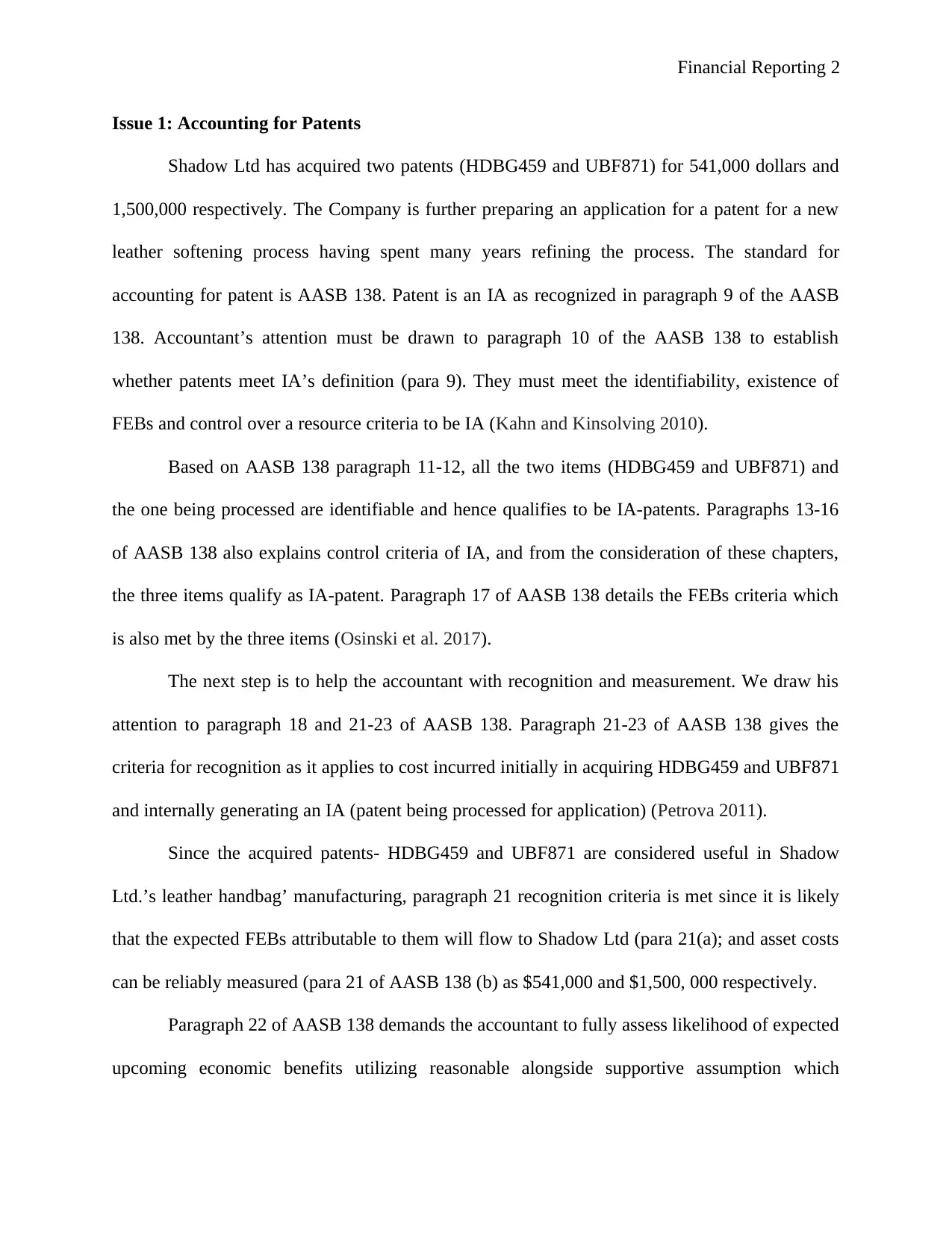
Financial Reporting 2
Issue 1: Accounting for Patents
Shadow Ltd has acquired two patents (HDBG459 and UBF871) for 541,000 dollars and
1,500,000 respectively. The Company is further preparing an application for a patent for a new
leather softening process having spent many years refining the process. The standard for
accounting for patent is AASB 138. Patent is an IA as recognized in paragraph 9 of the AASB
138. Accountant’s attention must be drawn to paragraph 10 of the AASB 138 to establish
whether patents meet IA’s definition (para 9). They must meet the identifiability, existence of
FEBs and control over a resource criteria to be IA (Kahn and Kinsolving 2010).
Based on AASB 138 paragraph 11-12, all the two items (HDBG459 and UBF871) and
the one being processed are identifiable and hence qualifies to be IA-patents. Paragraphs 13-16
of AASB 138 also explains control criteria of IA, and from the consideration of these chapters,
the three items qualify as IA-patent. Paragraph 17 of AASB 138 details the FEBs criteria which
is also met by the three items (Osinski et al. 2017).
The next step is to help the accountant with recognition and measurement. We draw his
attention to paragraph 18 and 21-23 of AASB 138. Paragraph 21-23 of AASB 138 gives the
criteria for recognition as it applies to cost incurred initially in acquiring HDBG459 and UBF871
and internally generating an IA (patent being processed for application) (Petrova 2011).
Since the acquired patents- HDBG459 and UBF871 are considered useful in Shadow
Ltd.’s leather handbag’ manufacturing, paragraph 21 recognition criteria is met since it is likely
that the expected FEBs attributable to them will flow to Shadow Ltd (para 21(a); and asset costs
can be reliably measured (para 21 of AASB 138 (b) as $541,000 and $1,500, 000 respectively.
Paragraph 22 of AASB 138 demands the accountant to fully assess likelihood of expected
upcoming economic benefits utilizing reasonable alongside supportive assumption which
Issue 1: Accounting for Patents
Shadow Ltd has acquired two patents (HDBG459 and UBF871) for 541,000 dollars and
1,500,000 respectively. The Company is further preparing an application for a patent for a new
leather softening process having spent many years refining the process. The standard for
accounting for patent is AASB 138. Patent is an IA as recognized in paragraph 9 of the AASB
138. Accountant’s attention must be drawn to paragraph 10 of the AASB 138 to establish
whether patents meet IA’s definition (para 9). They must meet the identifiability, existence of
FEBs and control over a resource criteria to be IA (Kahn and Kinsolving 2010).
Based on AASB 138 paragraph 11-12, all the two items (HDBG459 and UBF871) and
the one being processed are identifiable and hence qualifies to be IA-patents. Paragraphs 13-16
of AASB 138 also explains control criteria of IA, and from the consideration of these chapters,
the three items qualify as IA-patent. Paragraph 17 of AASB 138 details the FEBs criteria which
is also met by the three items (Osinski et al. 2017).
The next step is to help the accountant with recognition and measurement. We draw his
attention to paragraph 18 and 21-23 of AASB 138. Paragraph 21-23 of AASB 138 gives the
criteria for recognition as it applies to cost incurred initially in acquiring HDBG459 and UBF871
and internally generating an IA (patent being processed for application) (Petrova 2011).
Since the acquired patents- HDBG459 and UBF871 are considered useful in Shadow
Ltd.’s leather handbag’ manufacturing, paragraph 21 recognition criteria is met since it is likely
that the expected FEBs attributable to them will flow to Shadow Ltd (para 21(a); and asset costs
can be reliably measured (para 21 of AASB 138 (b) as $541,000 and $1,500, 000 respectively.
Paragraph 22 of AASB 138 demands the accountant to fully assess likelihood of expected
upcoming economic benefits utilizing reasonable alongside supportive assumption which
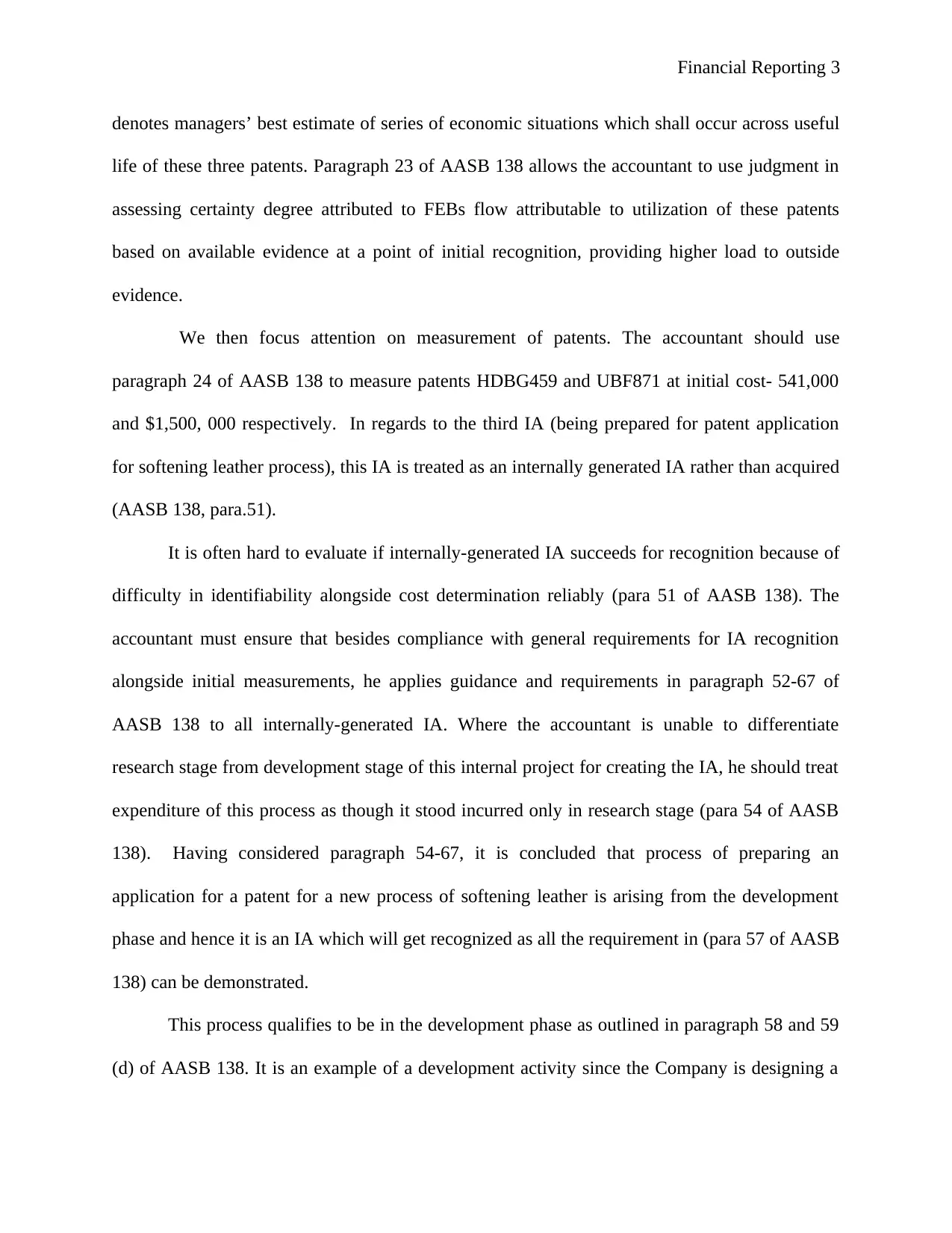
Financial Reporting 3
denotes managers’ best estimate of series of economic situations which shall occur across useful
life of these three patents. Paragraph 23 of AASB 138 allows the accountant to use judgment in
assessing certainty degree attributed to FEBs flow attributable to utilization of these patents
based on available evidence at a point of initial recognition, providing higher load to outside
evidence.
We then focus attention on measurement of patents. The accountant should use
paragraph 24 of AASB 138 to measure patents HDBG459 and UBF871 at initial cost- 541,000
and $1,500, 000 respectively. In regards to the third IA (being prepared for patent application
for softening leather process), this IA is treated as an internally generated IA rather than acquired
(AASB 138, para.51).
It is often hard to evaluate if internally-generated IA succeeds for recognition because of
difficulty in identifiability alongside cost determination reliably (para 51 of AASB 138). The
accountant must ensure that besides compliance with general requirements for IA recognition
alongside initial measurements, he applies guidance and requirements in paragraph 52-67 of
AASB 138 to all internally-generated IA. Where the accountant is unable to differentiate
research stage from development stage of this internal project for creating the IA, he should treat
expenditure of this process as though it stood incurred only in research stage (para 54 of AASB
138). Having considered paragraph 54-67, it is concluded that process of preparing an
application for a patent for a new process of softening leather is arising from the development
phase and hence it is an IA which will get recognized as all the requirement in (para 57 of AASB
138) can be demonstrated.
This process qualifies to be in the development phase as outlined in paragraph 58 and 59
(d) of AASB 138. It is an example of a development activity since the Company is designing a
denotes managers’ best estimate of series of economic situations which shall occur across useful
life of these three patents. Paragraph 23 of AASB 138 allows the accountant to use judgment in
assessing certainty degree attributed to FEBs flow attributable to utilization of these patents
based on available evidence at a point of initial recognition, providing higher load to outside
evidence.
We then focus attention on measurement of patents. The accountant should use
paragraph 24 of AASB 138 to measure patents HDBG459 and UBF871 at initial cost- 541,000
and $1,500, 000 respectively. In regards to the third IA (being prepared for patent application
for softening leather process), this IA is treated as an internally generated IA rather than acquired
(AASB 138, para.51).
It is often hard to evaluate if internally-generated IA succeeds for recognition because of
difficulty in identifiability alongside cost determination reliably (para 51 of AASB 138). The
accountant must ensure that besides compliance with general requirements for IA recognition
alongside initial measurements, he applies guidance and requirements in paragraph 52-67 of
AASB 138 to all internally-generated IA. Where the accountant is unable to differentiate
research stage from development stage of this internal project for creating the IA, he should treat
expenditure of this process as though it stood incurred only in research stage (para 54 of AASB
138). Having considered paragraph 54-67, it is concluded that process of preparing an
application for a patent for a new process of softening leather is arising from the development
phase and hence it is an IA which will get recognized as all the requirement in (para 57 of AASB
138) can be demonstrated.
This process qualifies to be in the development phase as outlined in paragraph 58 and 59
(d) of AASB 138. It is an example of a development activity since the Company is designing a
⊘ This is a preview!⊘
Do you want full access?
Subscribe today to unlock all pages.

Trusted by 1+ million students worldwide
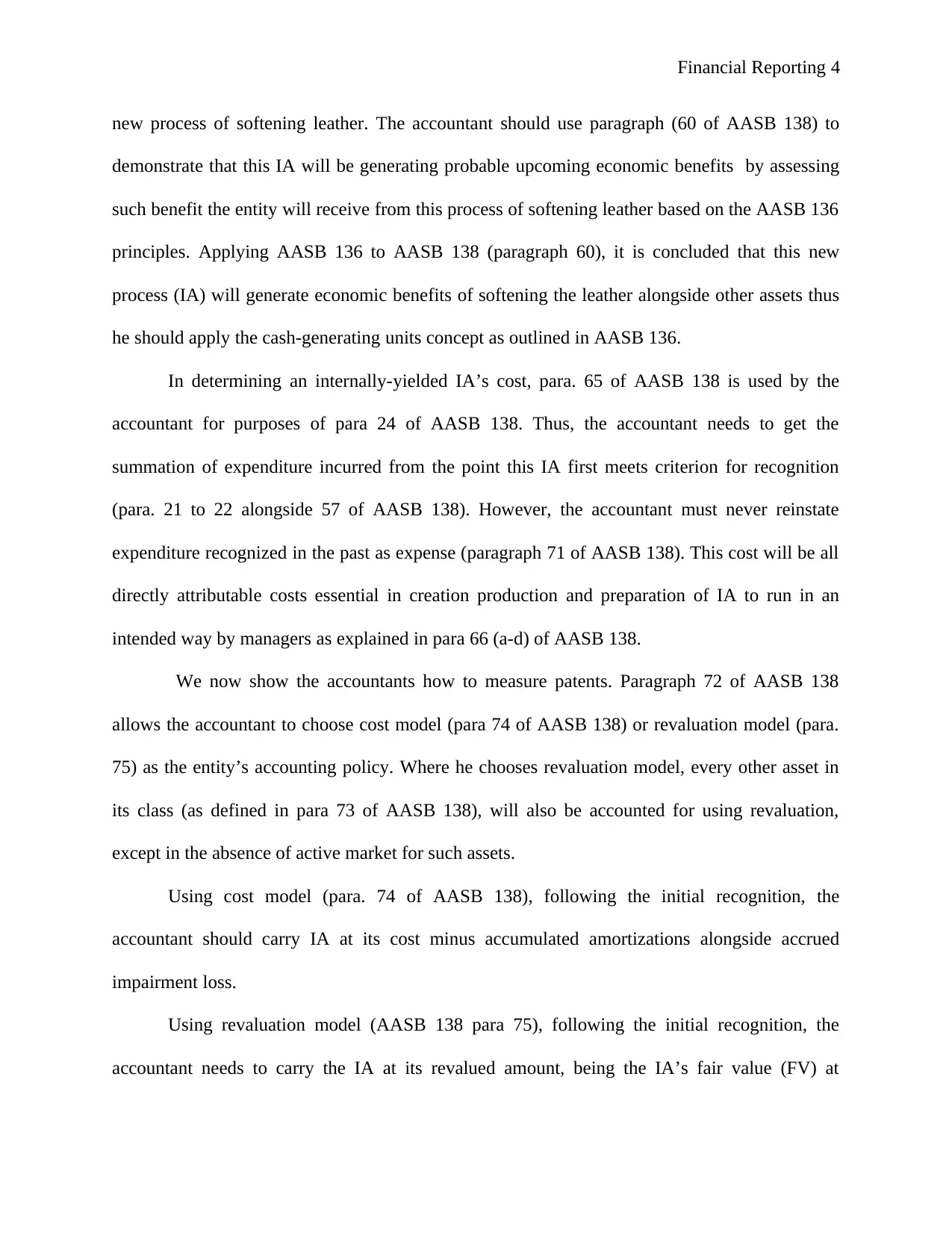
Financial Reporting 4
new process of softening leather. The accountant should use paragraph (60 of AASB 138) to
demonstrate that this IA will be generating probable upcoming economic benefits by assessing
such benefit the entity will receive from this process of softening leather based on the AASB 136
principles. Applying AASB 136 to AASB 138 (paragraph 60), it is concluded that this new
process (IA) will generate economic benefits of softening the leather alongside other assets thus
he should apply the cash-generating units concept as outlined in AASB 136.
In determining an internally-yielded IA’s cost, para. 65 of AASB 138 is used by the
accountant for purposes of para 24 of AASB 138. Thus, the accountant needs to get the
summation of expenditure incurred from the point this IA first meets criterion for recognition
(para. 21 to 22 alongside 57 of AASB 138). However, the accountant must never reinstate
expenditure recognized in the past as expense (paragraph 71 of AASB 138). This cost will be all
directly attributable costs essential in creation production and preparation of IA to run in an
intended way by managers as explained in para 66 (a-d) of AASB 138.
We now show the accountants how to measure patents. Paragraph 72 of AASB 138
allows the accountant to choose cost model (para 74 of AASB 138) or revaluation model (para.
75) as the entity’s accounting policy. Where he chooses revaluation model, every other asset in
its class (as defined in para 73 of AASB 138), will also be accounted for using revaluation,
except in the absence of active market for such assets.
Using cost model (para. 74 of AASB 138), following the initial recognition, the
accountant should carry IA at its cost minus accumulated amortizations alongside accrued
impairment loss.
Using revaluation model (AASB 138 para 75), following the initial recognition, the
accountant needs to carry the IA at its revalued amount, being the IA’s fair value (FV) at
new process of softening leather. The accountant should use paragraph (60 of AASB 138) to
demonstrate that this IA will be generating probable upcoming economic benefits by assessing
such benefit the entity will receive from this process of softening leather based on the AASB 136
principles. Applying AASB 136 to AASB 138 (paragraph 60), it is concluded that this new
process (IA) will generate economic benefits of softening the leather alongside other assets thus
he should apply the cash-generating units concept as outlined in AASB 136.
In determining an internally-yielded IA’s cost, para. 65 of AASB 138 is used by the
accountant for purposes of para 24 of AASB 138. Thus, the accountant needs to get the
summation of expenditure incurred from the point this IA first meets criterion for recognition
(para. 21 to 22 alongside 57 of AASB 138). However, the accountant must never reinstate
expenditure recognized in the past as expense (paragraph 71 of AASB 138). This cost will be all
directly attributable costs essential in creation production and preparation of IA to run in an
intended way by managers as explained in para 66 (a-d) of AASB 138.
We now show the accountants how to measure patents. Paragraph 72 of AASB 138
allows the accountant to choose cost model (para 74 of AASB 138) or revaluation model (para.
75) as the entity’s accounting policy. Where he chooses revaluation model, every other asset in
its class (as defined in para 73 of AASB 138), will also be accounted for using revaluation,
except in the absence of active market for such assets.
Using cost model (para. 74 of AASB 138), following the initial recognition, the
accountant should carry IA at its cost minus accumulated amortizations alongside accrued
impairment loss.
Using revaluation model (AASB 138 para 75), following the initial recognition, the
accountant needs to carry the IA at its revalued amount, being the IA’s fair value (FV) at
Paraphrase This Document
Need a fresh take? Get an instant paraphrase of this document with our AI Paraphraser
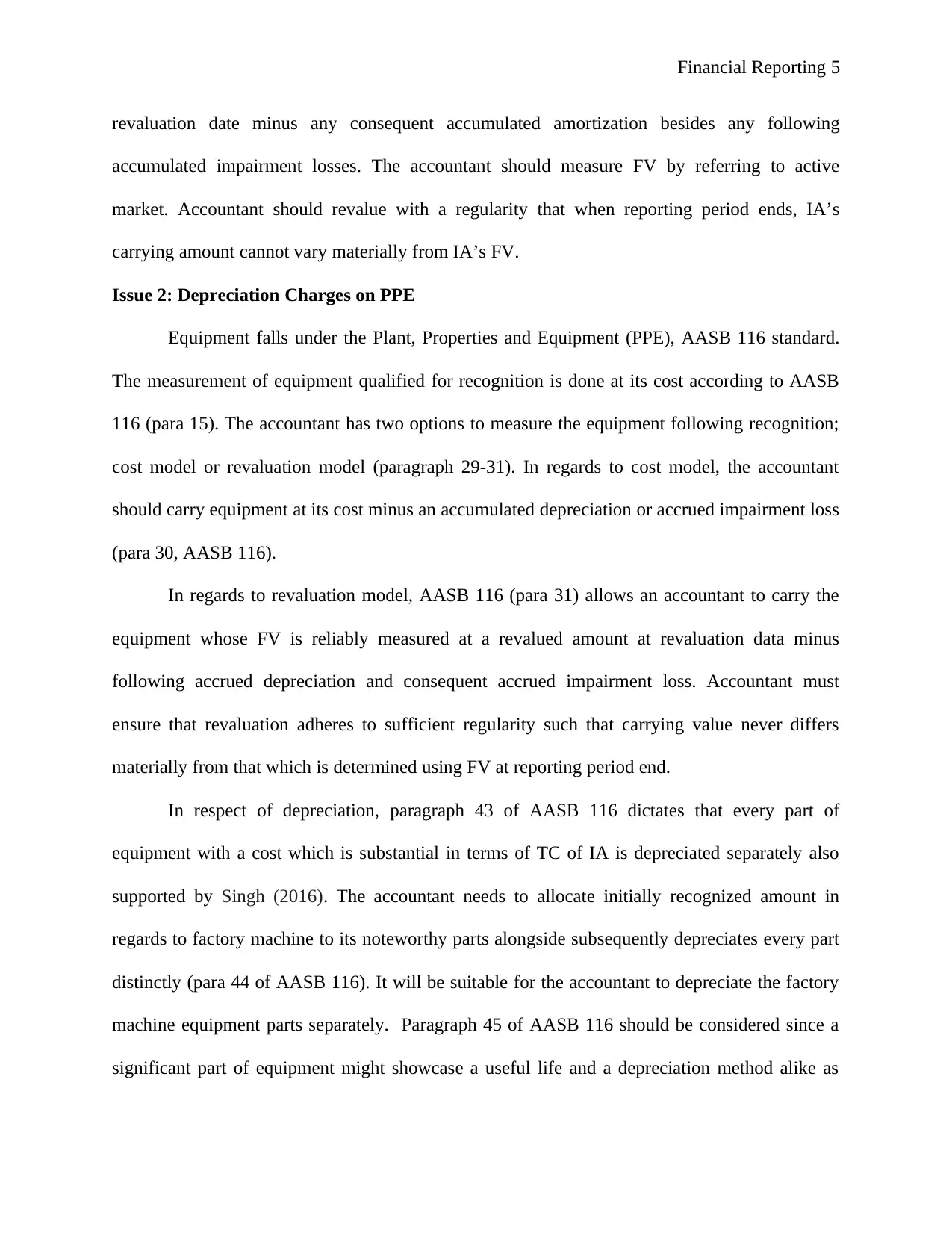
Financial Reporting 5
revaluation date minus any consequent accumulated amortization besides any following
accumulated impairment losses. The accountant should measure FV by referring to active
market. Accountant should revalue with a regularity that when reporting period ends, IA’s
carrying amount cannot vary materially from IA’s FV.
Issue 2: Depreciation Charges on PPE
Equipment falls under the Plant, Properties and Equipment (PPE), AASB 116 standard.
The measurement of equipment qualified for recognition is done at its cost according to AASB
116 (para 15). The accountant has two options to measure the equipment following recognition;
cost model or revaluation model (paragraph 29-31). In regards to cost model, the accountant
should carry equipment at its cost minus an accumulated depreciation or accrued impairment loss
(para 30, AASB 116).
In regards to revaluation model, AASB 116 (para 31) allows an accountant to carry the
equipment whose FV is reliably measured at a revalued amount at revaluation data minus
following accrued depreciation and consequent accrued impairment loss. Accountant must
ensure that revaluation adheres to sufficient regularity such that carrying value never differs
materially from that which is determined using FV at reporting period end.
In respect of depreciation, paragraph 43 of AASB 116 dictates that every part of
equipment with a cost which is substantial in terms of TC of IA is depreciated separately also
supported by Singh (2016). The accountant needs to allocate initially recognized amount in
regards to factory machine to its noteworthy parts alongside subsequently depreciates every part
distinctly (para 44 of AASB 116). It will be suitable for the accountant to depreciate the factory
machine equipment parts separately. Paragraph 45 of AASB 116 should be considered since a
significant part of equipment might showcase a useful life and a depreciation method alike as
revaluation date minus any consequent accumulated amortization besides any following
accumulated impairment losses. The accountant should measure FV by referring to active
market. Accountant should revalue with a regularity that when reporting period ends, IA’s
carrying amount cannot vary materially from IA’s FV.
Issue 2: Depreciation Charges on PPE
Equipment falls under the Plant, Properties and Equipment (PPE), AASB 116 standard.
The measurement of equipment qualified for recognition is done at its cost according to AASB
116 (para 15). The accountant has two options to measure the equipment following recognition;
cost model or revaluation model (paragraph 29-31). In regards to cost model, the accountant
should carry equipment at its cost minus an accumulated depreciation or accrued impairment loss
(para 30, AASB 116).
In regards to revaluation model, AASB 116 (para 31) allows an accountant to carry the
equipment whose FV is reliably measured at a revalued amount at revaluation data minus
following accrued depreciation and consequent accrued impairment loss. Accountant must
ensure that revaluation adheres to sufficient regularity such that carrying value never differs
materially from that which is determined using FV at reporting period end.
In respect of depreciation, paragraph 43 of AASB 116 dictates that every part of
equipment with a cost which is substantial in terms of TC of IA is depreciated separately also
supported by Singh (2016). The accountant needs to allocate initially recognized amount in
regards to factory machine to its noteworthy parts alongside subsequently depreciates every part
distinctly (para 44 of AASB 116). It will be suitable for the accountant to depreciate the factory
machine equipment parts separately. Paragraph 45 of AASB 116 should be considered since a
significant part of equipment might showcase a useful life and a depreciation method alike as

Financial Reporting 6
useful life and a method of depreciation of separate important part of same equipment and hence
the account needs to group these parts to determine charge on depreciation (Loon, Manicka and
Har 2017).
The accountant should note that the remainder of the machine equipment encompasses
individually insignificant parts (Kieso, Weygandt and Warfield 2016). Where the factory
machine has differing expectations for such parts, he should use approximation techniques when
depreciating remainder in a way which represents patterns of consumptions or parts’ useful life
faithfully (para 46 of AASB 116). The accountant must recognize depreciation charge for each
period in P&L unless he included them in another assets’ carrying amount (paragraph 48 of
AASB 116). The accountant need to recognize depreciation charge in P&L unless the FEBs
embodied in factory machine equipment get absorbed in other assets’ production (Liapis and
Kantianis 2015) and include depreciation charge on machine’s carrying amount because the
charge encompass part of other assets’ costs (para 49 of AASB 116).
In regards to depreciation amount and period, the accountant should assign depreciation
amount of factor machine systematically across its useful life (para 50 of AASB 116). He should
review useful life and residual value at the closure of every period besides where prospects vary
from past approximations, he should account for changes as a changes in estimates of accounting
based on AASB 108 (para 51 of AASB 116). The accountant must recognize deprecation even
when FV of factor machine surpasses its carrying amount provided the residual value stays
below its carrying amount irrespective of repair and maintenance (para 52 of AASB 116).
The accountant must first deduct residual value before determining depreciation amount
(para 53 of AASB 116) and where residual value surges to an amount equal or above carrying
amount, the accountant should record depreciation as zero until residual value declines to amount
useful life and a method of depreciation of separate important part of same equipment and hence
the account needs to group these parts to determine charge on depreciation (Loon, Manicka and
Har 2017).
The accountant should note that the remainder of the machine equipment encompasses
individually insignificant parts (Kieso, Weygandt and Warfield 2016). Where the factory
machine has differing expectations for such parts, he should use approximation techniques when
depreciating remainder in a way which represents patterns of consumptions or parts’ useful life
faithfully (para 46 of AASB 116). The accountant must recognize depreciation charge for each
period in P&L unless he included them in another assets’ carrying amount (paragraph 48 of
AASB 116). The accountant need to recognize depreciation charge in P&L unless the FEBs
embodied in factory machine equipment get absorbed in other assets’ production (Liapis and
Kantianis 2015) and include depreciation charge on machine’s carrying amount because the
charge encompass part of other assets’ costs (para 49 of AASB 116).
In regards to depreciation amount and period, the accountant should assign depreciation
amount of factor machine systematically across its useful life (para 50 of AASB 116). He should
review useful life and residual value at the closure of every period besides where prospects vary
from past approximations, he should account for changes as a changes in estimates of accounting
based on AASB 108 (para 51 of AASB 116). The accountant must recognize deprecation even
when FV of factor machine surpasses its carrying amount provided the residual value stays
below its carrying amount irrespective of repair and maintenance (para 52 of AASB 116).
The accountant must first deduct residual value before determining depreciation amount
(para 53 of AASB 116) and where residual value surges to an amount equal or above carrying
amount, the accountant should record depreciation as zero until residual value declines to amount
⊘ This is a preview!⊘
Do you want full access?
Subscribe today to unlock all pages.

Trusted by 1+ million students worldwide
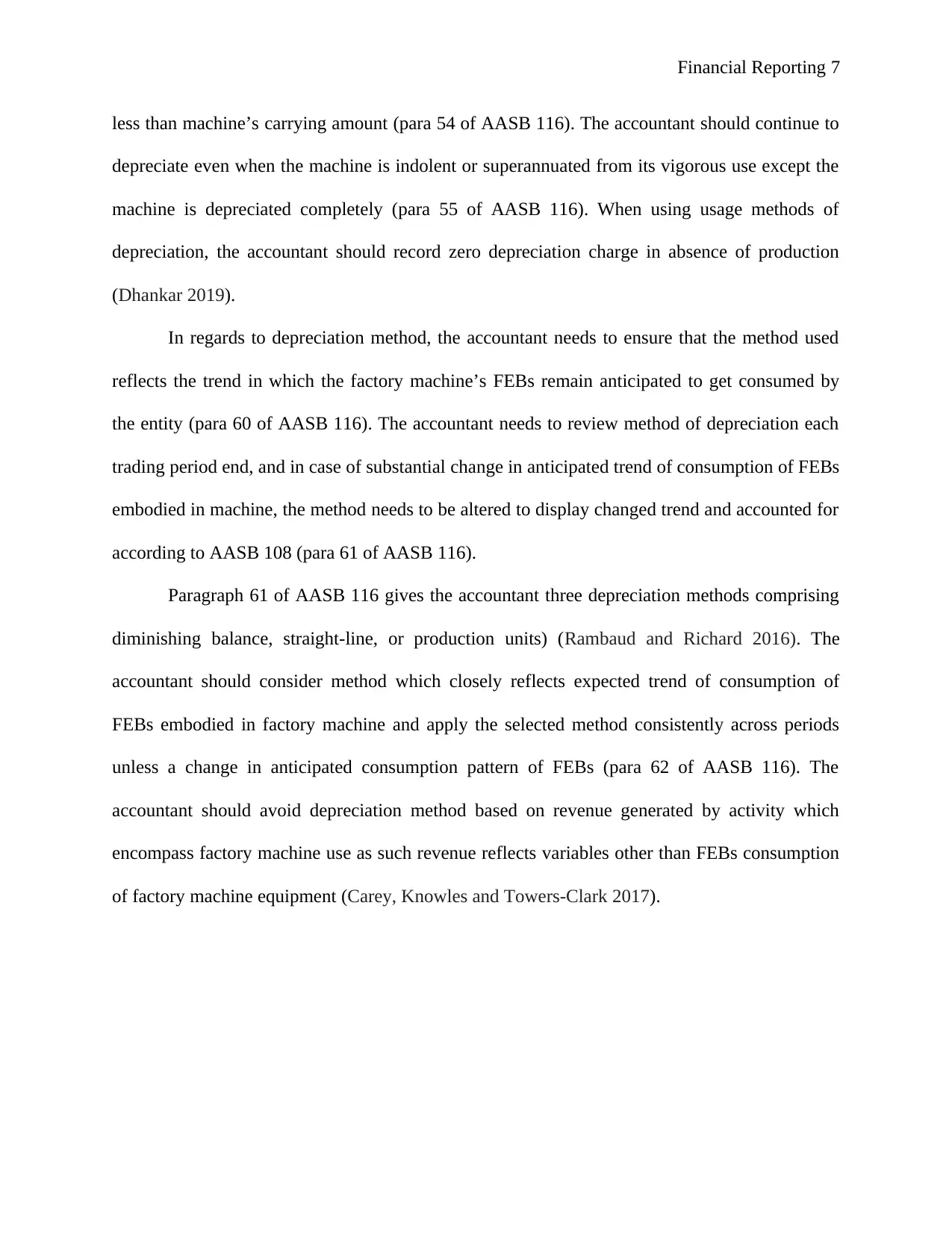
Financial Reporting 7
less than machine’s carrying amount (para 54 of AASB 116). The accountant should continue to
depreciate even when the machine is indolent or superannuated from its vigorous use except the
machine is depreciated completely (para 55 of AASB 116). When using usage methods of
depreciation, the accountant should record zero depreciation charge in absence of production
(Dhankar 2019).
In regards to depreciation method, the accountant needs to ensure that the method used
reflects the trend in which the factory machine’s FEBs remain anticipated to get consumed by
the entity (para 60 of AASB 116). The accountant needs to review method of depreciation each
trading period end, and in case of substantial change in anticipated trend of consumption of FEBs
embodied in machine, the method needs to be altered to display changed trend and accounted for
according to AASB 108 (para 61 of AASB 116).
Paragraph 61 of AASB 116 gives the accountant three depreciation methods comprising
diminishing balance, straight-line, or production units) (Rambaud and Richard 2016). The
accountant should consider method which closely reflects expected trend of consumption of
FEBs embodied in factory machine and apply the selected method consistently across periods
unless a change in anticipated consumption pattern of FEBs (para 62 of AASB 116). The
accountant should avoid depreciation method based on revenue generated by activity which
encompass factory machine use as such revenue reflects variables other than FEBs consumption
of factory machine equipment (Carey, Knowles and Towers-Clark 2017).
less than machine’s carrying amount (para 54 of AASB 116). The accountant should continue to
depreciate even when the machine is indolent or superannuated from its vigorous use except the
machine is depreciated completely (para 55 of AASB 116). When using usage methods of
depreciation, the accountant should record zero depreciation charge in absence of production
(Dhankar 2019).
In regards to depreciation method, the accountant needs to ensure that the method used
reflects the trend in which the factory machine’s FEBs remain anticipated to get consumed by
the entity (para 60 of AASB 116). The accountant needs to review method of depreciation each
trading period end, and in case of substantial change in anticipated trend of consumption of FEBs
embodied in machine, the method needs to be altered to display changed trend and accounted for
according to AASB 108 (para 61 of AASB 116).
Paragraph 61 of AASB 116 gives the accountant three depreciation methods comprising
diminishing balance, straight-line, or production units) (Rambaud and Richard 2016). The
accountant should consider method which closely reflects expected trend of consumption of
FEBs embodied in factory machine and apply the selected method consistently across periods
unless a change in anticipated consumption pattern of FEBs (para 62 of AASB 116). The
accountant should avoid depreciation method based on revenue generated by activity which
encompass factory machine use as such revenue reflects variables other than FEBs consumption
of factory machine equipment (Carey, Knowles and Towers-Clark 2017).
Paraphrase This Document
Need a fresh take? Get an instant paraphrase of this document with our AI Paraphraser
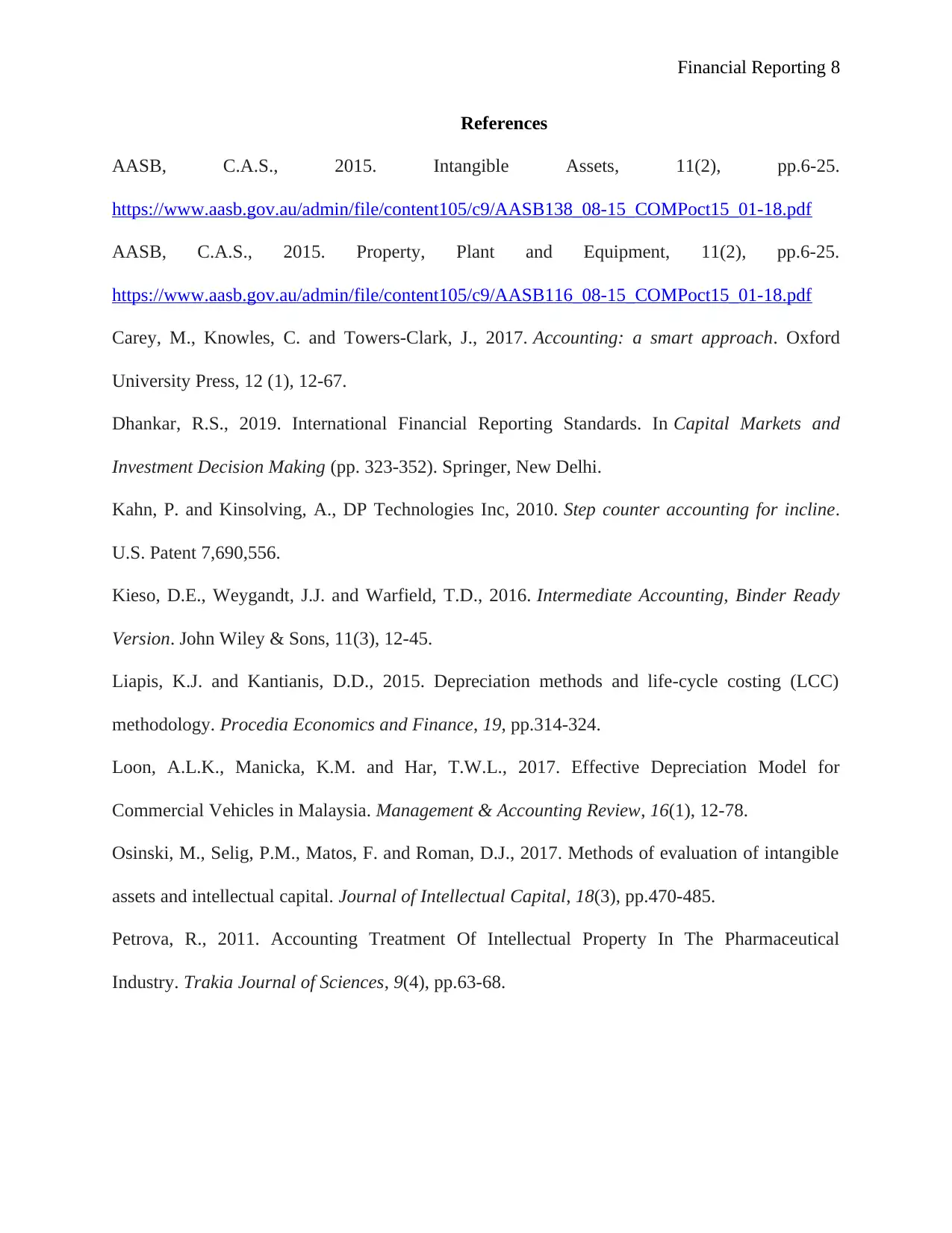
Financial Reporting 8
References
AASB, C.A.S., 2015. Intangible Assets, 11(2), pp.6-25.
https://www.aasb.gov.au/admin/file/content105/c9/AASB138_08-15_COMPoct15_01-18.pdf
AASB, C.A.S., 2015. Property, Plant and Equipment, 11(2), pp.6-25.
https://www.aasb.gov.au/admin/file/content105/c9/AASB116_08-15_COMPoct15_01-18.pdf
Carey, M., Knowles, C. and Towers-Clark, J., 2017. Accounting: a smart approach. Oxford
University Press, 12 (1), 12-67.
Dhankar, R.S., 2019. International Financial Reporting Standards. In Capital Markets and
Investment Decision Making (pp. 323-352). Springer, New Delhi.
Kahn, P. and Kinsolving, A., DP Technologies Inc, 2010. Step counter accounting for incline.
U.S. Patent 7,690,556.
Kieso, D.E., Weygandt, J.J. and Warfield, T.D., 2016. Intermediate Accounting, Binder Ready
Version. John Wiley & Sons, 11(3), 12-45.
Liapis, K.J. and Kantianis, D.D., 2015. Depreciation methods and life-cycle costing (LCC)
methodology. Procedia Economics and Finance, 19, pp.314-324.
Loon, A.L.K., Manicka, K.M. and Har, T.W.L., 2017. Effective Depreciation Model for
Commercial Vehicles in Malaysia. Management & Accounting Review, 16(1), 12-78.
Osinski, M., Selig, P.M., Matos, F. and Roman, D.J., 2017. Methods of evaluation of intangible
assets and intellectual capital. Journal of Intellectual Capital, 18(3), pp.470-485.
Petrova, R., 2011. Accounting Treatment Of Intellectual Property In The Pharmaceutical
Industry. Trakia Journal of Sciences, 9(4), pp.63-68.
References
AASB, C.A.S., 2015. Intangible Assets, 11(2), pp.6-25.
https://www.aasb.gov.au/admin/file/content105/c9/AASB138_08-15_COMPoct15_01-18.pdf
AASB, C.A.S., 2015. Property, Plant and Equipment, 11(2), pp.6-25.
https://www.aasb.gov.au/admin/file/content105/c9/AASB116_08-15_COMPoct15_01-18.pdf
Carey, M., Knowles, C. and Towers-Clark, J., 2017. Accounting: a smart approach. Oxford
University Press, 12 (1), 12-67.
Dhankar, R.S., 2019. International Financial Reporting Standards. In Capital Markets and
Investment Decision Making (pp. 323-352). Springer, New Delhi.
Kahn, P. and Kinsolving, A., DP Technologies Inc, 2010. Step counter accounting for incline.
U.S. Patent 7,690,556.
Kieso, D.E., Weygandt, J.J. and Warfield, T.D., 2016. Intermediate Accounting, Binder Ready
Version. John Wiley & Sons, 11(3), 12-45.
Liapis, K.J. and Kantianis, D.D., 2015. Depreciation methods and life-cycle costing (LCC)
methodology. Procedia Economics and Finance, 19, pp.314-324.
Loon, A.L.K., Manicka, K.M. and Har, T.W.L., 2017. Effective Depreciation Model for
Commercial Vehicles in Malaysia. Management & Accounting Review, 16(1), 12-78.
Osinski, M., Selig, P.M., Matos, F. and Roman, D.J., 2017. Methods of evaluation of intangible
assets and intellectual capital. Journal of Intellectual Capital, 18(3), pp.470-485.
Petrova, R., 2011. Accounting Treatment Of Intellectual Property In The Pharmaceutical
Industry. Trakia Journal of Sciences, 9(4), pp.63-68.
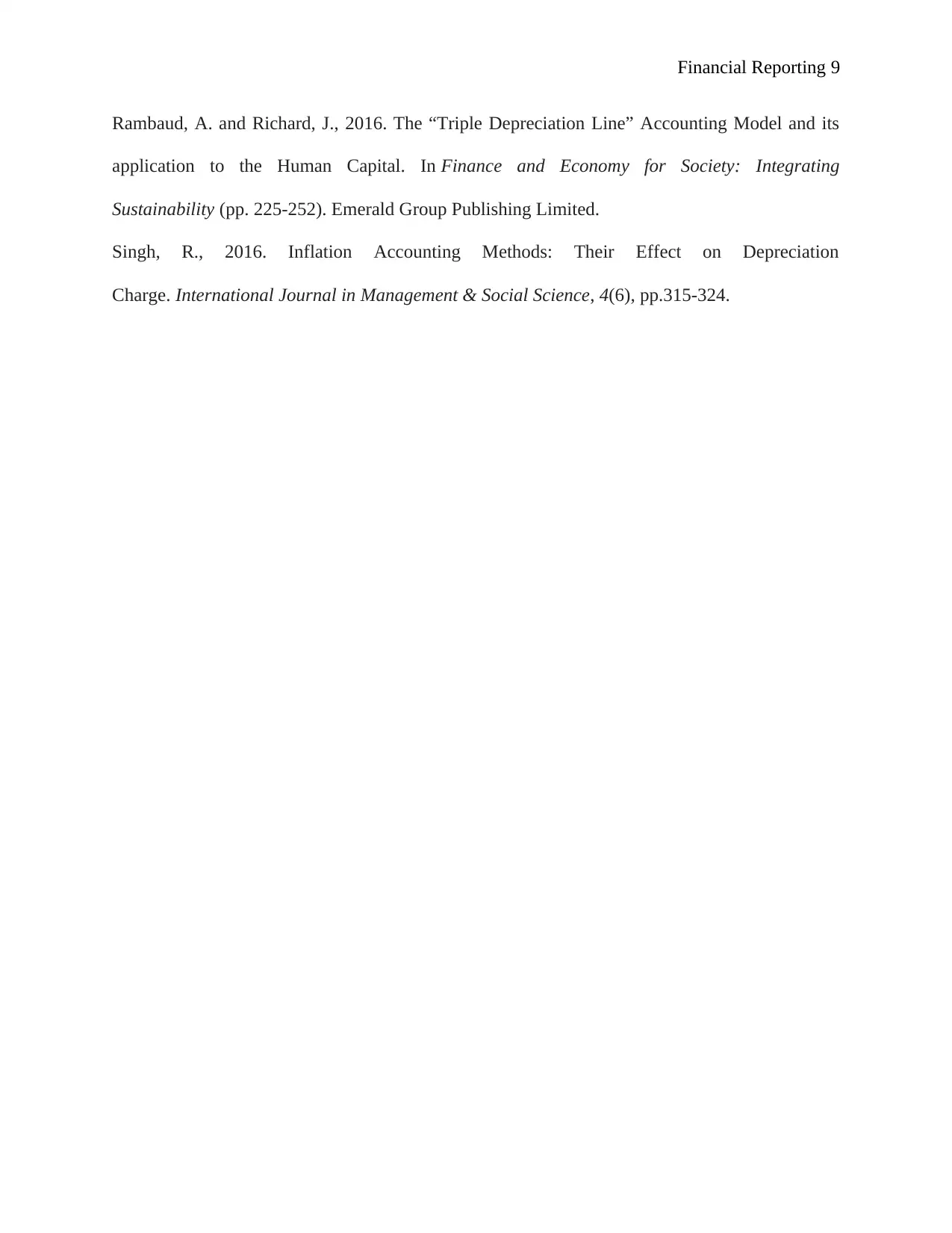
Financial Reporting 9
Rambaud, A. and Richard, J., 2016. The “Triple Depreciation Line” Accounting Model and its
application to the Human Capital. In Finance and Economy for Society: Integrating
Sustainability (pp. 225-252). Emerald Group Publishing Limited.
Singh, R., 2016. Inflation Accounting Methods: Their Effect on Depreciation
Charge. International Journal in Management & Social Science, 4(6), pp.315-324.
Rambaud, A. and Richard, J., 2016. The “Triple Depreciation Line” Accounting Model and its
application to the Human Capital. In Finance and Economy for Society: Integrating
Sustainability (pp. 225-252). Emerald Group Publishing Limited.
Singh, R., 2016. Inflation Accounting Methods: Their Effect on Depreciation
Charge. International Journal in Management & Social Science, 4(6), pp.315-324.
⊘ This is a preview!⊘
Do you want full access?
Subscribe today to unlock all pages.

Trusted by 1+ million students worldwide
1 out of 9
Related Documents
Your All-in-One AI-Powered Toolkit for Academic Success.
+13062052269
info@desklib.com
Available 24*7 on WhatsApp / Email
![[object Object]](/_next/static/media/star-bottom.7253800d.svg)
Unlock your academic potential
Copyright © 2020–2025 A2Z Services. All Rights Reserved. Developed and managed by ZUCOL.



